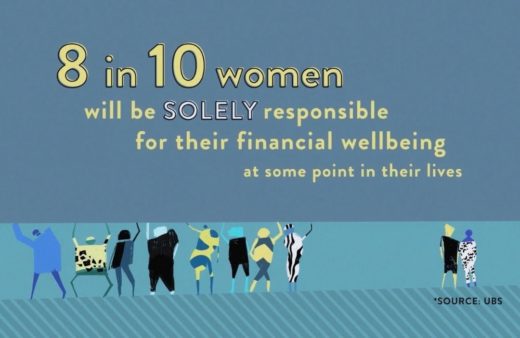
Robin Hauser’s passion is making documentaries with purpose — creating cause-based films that raise awareness of pressing societal issues with the goal to educate and motivate her audience to take action. Her latest film, $avvy, is a revealing and sometimes shocking look at the cultural reasons why women are often lacking in financial awareness, and why it’s critical for women to understand and take control of their personal finances. The process of making this documentary was like no other — half-way through the production of the documentary COVID-19 restrictions hit in full force, which nearly put a halt to the film. But Hauser felt strongly that $avvy was a film that needed to be made.
“I’ve always considered myself financially savvy,” Hauser said, explaining the inspiration behind the documentary. “I grew up with a father who was an investment counselor, and I worked in the stock market when I first got out of business school. But when I got married and had kids, I didn’t really work full-time for 25 years, apart from having a photography side job. Like many women, and many mothers, my task was to raise the kids, not necessarily to manage finances.”
At the age of 50, Hauser got divorced and for the first time in 25 years, she was solely responsible for her financial well-being. It opened her eyes to what other women were going through.
“That’s when I broke the taboo of speaking about money,” she recalled. “I talked to a lot of my friends and was surprised at what I was hearing. So many women were abdicating financial decisions to their husbands. It was shocking for me to learn how vulnerable we are if we’re not taking an active role in understanding our finances.”
A new remote editing workflow
By the time COVID-19 turned the world upside down, the $avvy team had shot some footage and created a demo reel for the documentary — there was, however, a lot of filming still to do. The original plan included shoots up to and including May 2020, none of which were possible anymore.
“We basically stopped all production,” Hauser explained. “It would have been easier if we had been at the editing stage already, which you can handle more effectively from home. We still had shooting to do, but fortunately we had filmed enough to start piecing together some scenes.”
To stay connected and creative, together, the team made use of Adobe Team Projects to collaborate remotely. It was the first time editor Shirley Thompson, who’s based in Hawaii, and assistant editor Annie Munger, based in California, couldn’t work together in the same room — an intimidating concept, but one that yielded great results.
“It was really exciting and a great learning experience,” Munger remembered. “Without Team Projects and the help of the Adobe team, the process of sending files back and forth to each other would have been very laborious and messy. It saved us a lot of time and effort. For an editor, there’s always a bit of nervousness involved when you’re using new technology, but the Adobe team was incredibly patient and supportive throughout the whole process.”
Usually, the production team would also shoot supplemental or alternative footage (a.k.a. B-roll), but due to social-distancing restrictions, they simply didn’t have a way to gather material. Getting everyday scenes of people on the streets, eating in restaurants, or sitting outside a cafe suddenly posed a major challenge.
“Adobe stock footage became critical when we dug into editing the feature-length version of the film,” Munger explained. “We started by searching for ‘women, money, finances’ but the crux of the film is that it’s not just about money — it’s about the way it impacts every aspect of women’s life, which allowed us to broaden our search and find lots of elements for storytelling. We were also focused on finding stock that looked authentic and could pass as documentary footage.
“Every filmmaker, especially if you’re making documentaries, wants to find stock that doesn’t look like stock because you don’t want anybody in the audience to know that you didn’t film these scenes,” Hauser added. “So we mined through the Adobe Stock library to find shots that looked like what we would have filmed. We wanted real people doing everyday things who don’t look like they’re posing, and we were really pleased with what we were able to find.”

Fundraising in the age of COVID
The pandemic not only disrupted the schedule, but threatened the film’s budget as well. Many of Hauser’s usual fundraising sources suddenly pivoted their priorities to direct frontline COVID-19 relief, for example by making face masks or helping out hospitals.
“It made it very difficult to fundraise for the film for about three months,” Hauser explained. “Never before had I still been fundraising the week that we were putting the film’s credits together. We were counting our pennies till the very end.”
COVID-19 permanently changed the way Finish Line Features creates its films, and the team is more apt now to add remote workflows in future projects. Adobe Team Projects turned out to be a radically transformative tool the team will make use of going forward to creatively collaborate more efficiently.
$avvy, meanwhile, has already won three awards of excellence in the “documentary feature,” “contemporary issues/awareness raising,” and “use of film/video for social change” categories at the IMPACT DOCS Awards.
“If anybody in the audience, regardless of gender, is motivated to take charge of their finances, start investing, or improve their credit score, then I think we’ve done our job as filmmakers,” Hauser concluded.
“We hope to bring awareness to the fact that if you’re not savvy about your finances and you suddenly become widowed, get divorced, or are impacted by an emergency, it can be really stressful. $avvy is a reminder that it’s empowering, exciting, and fun to be in charge of your own finances and to have a grasp on both your financial future and your power not only as a woman but also as an individual.”

Filmtools
Filmmakers go-to destination for pre-production, production & post production equipment!
Shop Now













